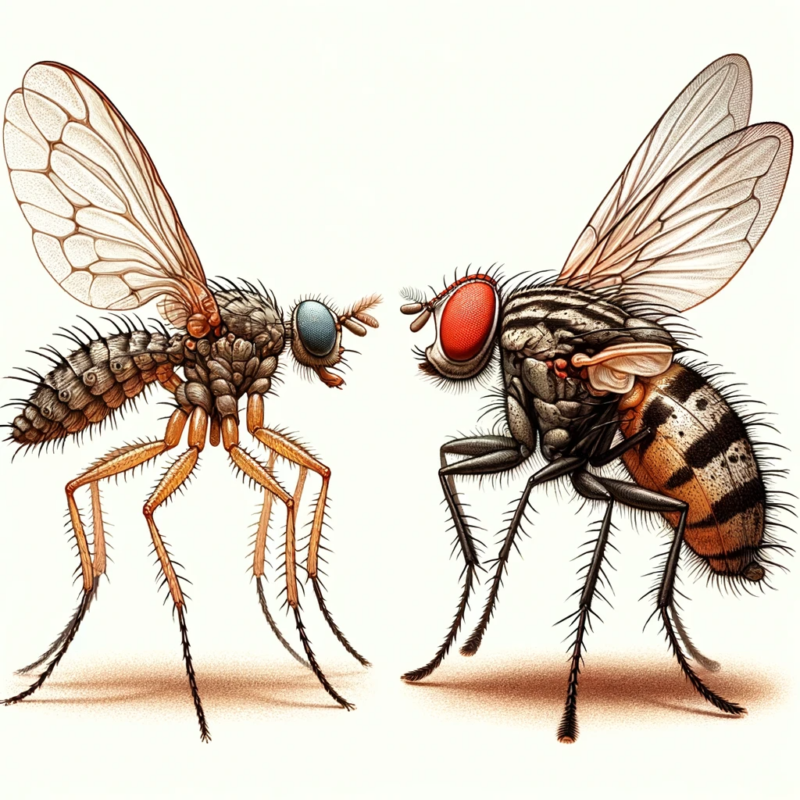Fruit Fly Facts
4 Difference Between Gnat vs Fruit Fly
Tiny flying insects buzzing around your home can be a frustrating problem. Often referred to as gnats, these pests can be a nuisance and may indicate issues with moisture or sanitation. Before taking steps to remove them, it’s important to identify the specific type of insect. Two common culprits are gnat vs fruit fly. While these insects may appear similar, there are key differences in their appearance, behavior, and preferred environments. Understanding these differences will help you select the most effective control methods.
Key Takeaways:
- Gnats and fruit flies look and behave differently.
- Effective pest control depends on accurate identification.
- Preventive measures like removing rotting food and managing moisture are important.
Understanding The Difference Between Gnat vs Fruit Fly
Appearance
Fruit flies
Fruit flies have a stockier build with a rounded body shape, similar to a miniature house fly. They usually measure around 1/8 inch (3 millimeters) in length.
Gnats

Gnats possess slender bodies and longer legs, making them resemble mosquitoes. Their size varies between species. Fungus gnats, for instance, typically reach about 1/16 inch (1.5 millimeters), while some drain flies can grow slightly larger at about 1/4 inch (6 millimeters).
Color

Fruit flies: Fruit flies exhibit a range of tan and brown shades. Gnats: Gnats are most commonly dark gray or black. Certain species, like fungus gnats, may have slightly lighter body colors.
Eyes
Fruit flies have prominent red eyes that are easily noticeable. On the other hand, gnats have very small eyes that are difficult to see with the naked eye.
Attraction
Fruit flies: Fruit flies are primarily drawn to overripe or fermenting fruits and vegetables. They may also be found around sugary drinks, open trash cans, or drains. Gnats: Gnats are attracted to different sources depending on the species. Fungus gnats are attracted to damp soil, often found in the vicinity of houseplants. Other gnat types, such as drain flies, breed in moist drains and garbage disposals. Certain species may bite humans.
Fruit Flies: A Persistent Indoor Problem
Fruit flies, including the red-eyed fruit fly and the dark-eyed fruit fly, are a familiar sight in many kitchens. These pests are attracted to fermenting fruits and vegetables, making them a common problem in areas where food is stored. Unlike gnats, fruit flies are indoor pests that thrive in the presence of ripe or decomposing organic matter.
The fruit fly problem escalates quickly due to their rapid breeding cycle. These pests lay eggs on the surface of fermenting fruits, with larvae emerging to feed on the decomposing material. This cycle can lead to significant infestations if not addressed promptly.
Getting Rid of Gnats and Fruit Flies
Natural and Chemical Control Strategies

Controlling these pests can be achieved through a combination of natural and chemical methods. For fruit flies, homemade traps using apple cider vinegar and plastic wrap are effective. Similarly, natural remedies like neem oil can help control fungus gnat infestations in potted plants.
In cases where natural methods are insufficient, chemical pesticides can be used. However, these should be a last resort due to their potential impact on the environment and human health.
Read more: The 5 Best Fruit Fly Traps in 2024
Prevention: A Proactive Approach
Prevention is always better than cure when it comes to pest control. Regular cleaning and waste management are crucial in keeping both gnats and fruit flies at bay. This includes removing overripe fruits, sealing garbage cans, and ensuring kitchen areas are clean and free of food residues.
For gnats, reducing moisture in plants and soil is vital. This might involve adjusting watering schedules for indoor plants and fixing any leaky faucets or pipes that create damp environments.

Professional Pest Control: When to Seek Help
There are instances where professional pest control services are necessary. Severe infestations or recurring pest problems might require the expertise of trained professionals who can provide targeted and effective treatment options.
Read more: How to get rid of fruit flies?
Do fruit fly traps also work for gnats?
Yes! Fruit fly traps work for gnats.
Fruit flies are attracted to the same things you are: ripe fruit, overripe fruit, and other food that’s been left out too long. So if you have fruit flies in your home, chances are good that you also have other flies who are looking for a free meal.
Gnats are also attracted to rotting fruit and damp environments—which is why they’re often found near drains or in basements. They tend to live in groups, so if you see one gnat buzzing around, there are probably more nearby waiting to get their share of the spoils.
To keep your home free of these pests, use a trap like Fruit Fly Jar Trap. This trap uses natural ingredients like yeast and apple cider vinegar to attract both fruit flies and gnats, which means it works on both types of pests!
Conclusion: Comprehensive Management for Peace of Mind
In conclusion, the battle against gnats and fruit flies requires a comprehensive approach. Understanding their distinct characteristics and breeding habits is key. For instance, fruit flies, both the red-eyed and dark-eyed varieties, are often drawn to a fruit bowl in kitchens, attracted by the sweet scent of ripening or overripe fruits. This common household scenario underscores the importance of awareness of their preferences. Effective control measures, therefore, include not only regular cleaning and proper waste management but also paying attention to everyday household items like fruit bowls. Ensuring these are regularly emptied or covered can be a simple yet effective strategy. Implementing targeted control strategies and maintaining vigilance can help manage these common household pests, ensuring a more peaceful and pest-free living environment.

Hi there! I’m Beliz Güner, and welcome to my world of innovative solutions for fruit fly challenges. Though I hail from Turkey and have a background in interior design, my true passion lies in tackling the persistent issue of fruit flies. My journey has been anything but ordinary, as I’ve transitioned from creating beautiful spaces to devising effective fruit fly traps.
My interest in DIY home projects and product reviews has fueled my desire to share knowledge and personal experiences with others facing similar frustrations. Through my blog, I aim to empower you with the tools and insights needed to combat fruit fly invasions, drawing on my unique blend of design creativity and hands-on experimentation. Join me as we explore the most effective strategies to reclaim our homes from these unwelcome guests.

